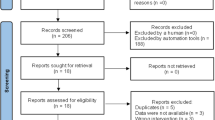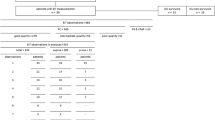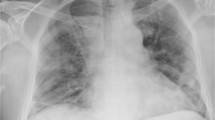Abstract
Introduction
Respiratory complications (RC) are a leading cause of death after spinal cord injury (SCI) due to compromised immune function and respiratory muscle weakness. Thus, individuals with SCI are at high risk of developing COVID-19 related RC. Results of a SCI clinical trial showed a supervised respiratory muscle training (RMT) program decreased risk of developing RC. The feasibility of conducting unsupervised RMT is not well documented. Four publications (n = 117) were identified in which unsupervised RMT was performed. Significant improvements in respiratory outcomes were reported in two studies: Maximal Inspiratory and Expiratory Pressure (MIP40% and MEP25%, respectively), Peak Expiratory Flow (PEF9%), seated and supine Forced Vital Capacity (FVC23% and 26%, respectively), and Peak Cough Flow (28%). This review and case report will attempt to show that an inspiratory muscle training (IMT) home exercise program (HEP) is feasible and may prepare the respiratory system for RC associated with COVID-19 in patients with SCI.
Case presentation
A 23-year-old with tetraplegia (P1), history of mechanical ventilation, and hospitalization for RC, completed 27 IMT HEP sessions in one month. MIP and sustained MIP (SMIP) increased from baseline by 28% and 26.5%, respectively. Expiratory volumes and rates also improved (FVC, FEV1, and PEF: 11.7%, 8.3%, and 14.2%, respectively).
Discussion
The effects of COVID-19 on patients with SCI remains inconclusive, but recent literature and the results of this case suggest that unsupervised IMT is feasible and may limit the severity of RC in patients with SCI who contract COVID-19.
Similar content being viewed by others
Log in or create a free account to read this content
Gain free access to this article, as well as selected content from this journal and more on nature.com
or
References
Savic G, DeVivo MJ, Frankel HL, Jamous MA, Soni BM, Charlifue S. Causes of death after traumatic spinal cord injury-a 70-year British study. Spinal Cord. 2017;55:891–97. https://doi.org/10.1038/sc.2017.64.
McDonald T, Stiller K. Inspiratory muscle training is feasible and safe for patients with acute spinal cord injury. J Spinal Cord Med. 2018:1–8. https://doi.org/10.1080/10790268.2018.1432307.
Krause JS, Cao Y, DeVivo MJ, DiPiro ND. Risk and protective factors for cause-specific mortality after spinal cord injury. Arch Phys Med Rehabil. 2016;97:1669–78. https://doi.org/10.1016/j.apmr.2016.07.001.
Berlly M, Shem K. Respiratory management during the first five days after spinal cord injury. J Spinal Cord Med. 2007;30:309–18. https://doi.org/10.1080/10790268.2007.11753946.
Kopp MA, Watzlawick R, Martus P, Failli V, Finkenstaedt FW, Chen Y, et al. Long-term functional outcome in patients with acquired infections after acute spinal cord injury. Neurology. 2017;88:892–900. https://doi.org/10.1212/WNL.0000000000003652.
Leite VF, Souza DR, Imamura M, Battistella LR. Post-discharge mortality in patients with traumatic spinal cord injury in a Brazilian hospital: a retrospective cohort. Spinal Cord. 2019;57:134–40. https://doi.org/10.1038/s41393-018-0183-y.
Claxton AR, Wong DT, Chung F, Fehlings MG. Predictors of hospital mortality and mechanical ventilation in patients with cervical spinal cord injury. Can J Anaesth. 1998;45:144–9. https://doi.org/10.1007/BF03013253.
Chen N, Zhou M, Dong X, Qu J, Gong F, Han Y, et al. Epidemiological and clinical characteristics of 99 cases of 2019 novel coronavirus pneumonia in Wuhan, China: a descriptive study. Lancet. 2020;395:507–13. https://doi.org/10.1016/S0140-6736(20)30211-7.
Guan WJ, Ni ZY, Hu Y, Liang WH, Ou CQ, He JX, et al. Clinical characteristics of coronavirus disease 2019 in China. N. Engl J Med. 2020;382:1708–20. https://doi.org/10.1056/NEJMoa2002032.
Huang C, Wang Y, Li X, Ren L, Zhao J, Hu Y, et al. Clinical features of patients infected with 2019 novel coronavirus in Wuhan, China. Lancet. 2020;395:497–506. https://doi.org/10.1016/S0140-6736(20)30183-5.
Wang D, Hu B, Hu C, Zhu F, Liu X, Zhang J, et al. Clinical characteristics of 138 hospitalized patients with 2019 novel coronavirus-infected pneumonia in Wuhan, China. JAMA. 2020 https://doi.org/10.1001/jama.2020.1585.
López-Dolado E, Gil-Agudo A. Lessons learned from the coronavirus disease 2019 (Covid-19) outbreak in a monographic center for spinal cord injury. Spinal Cord. 2020. https://doi.org/10.1038/s41393-020-0473-z.
Malfatti CG, Cortés PB, Fernández A, Ureña PJC, Baquero EV, Henares FG, et al. Respiratory rehabilitation protocol for patients with spinal cord injury and COVID-19. Secondary Respiratory rehoabilitation protocol for patients with spinal cord injury and COVID-19 2020. https://www.iscos.org.uk/uploads/CV-19/updated%20files%204%2024%2020/ENG_SCI_and_COVID_19_Respiratory.pdf. Accessed Date: 30 May 2020.
Gil-Agudo A, Jimenez-Velasco I, Gutierrez-Henares F, Lopez-Dolado E, Gambarrutta-Malfatti C, Vargas-Baquero E. Clinical features of coronavirus disease 2019 (COVID-19) in a cohort of patients with disability due to spinal cord injury. MedRXiv. 2020. https://doi.org/10.1101/2020.04.20.20072918.
Sánchez-Raya J, Sampol J. Spinal cord injury and COVID-19: some thoughts after the first wave. Spinal Cord. 2020. https://doi.org/10.1038/s41393-020-0524-5.
Righi G, Del Popolo G. COVID-19 tsunami: the first case of a spinal cord injury patient in Italy. Spinal Cord Ser Cases. 2020;6:22. https://doi.org/10.1038/s41394-020-0274-9.
Korupolu R, Stampas A, Gibbons C, Hernandez Jimenez I, Skelton F, Verduzco-Gutierrez M. COVID-19: Screening and triage challenges in people with disability due to Spinal Cord Injury. Spinal Cord Ser Cases. 2020;6:35. https://doi.org/10.1038/s41394-020-0284-7.
Pattanakuhar S, Tangvinit C, Kovindha A. A patient with acute cervical cord injury and COVID-19: a first case report. Am J Phys Med Rehabil. 2020. https://doi.org/10.1097/PHM.0000000000001485.
Ayyildiz A, Kuran B, Altoparlak B, Dogu B, Yilmaz F. Complications of spinal cord injury can hide fever and cough associated to COVID-19. Asian J Case Rep. Med Health. 2020;3:1–5.
Stillman MD, Capron M, Alexander M, Di Giusto ML, Scivoletto G. COVID-19 and spinal cord injury and disease: results of an international survey. Spinal Cord Ser Cases. 2020;6:21. https://doi.org/10.1038/s41394-020-0275-8.
Severin R, Arena R, Lavie CJ, Bond S, Phillips SA. Respiratory muscle performance screening for infectious disease management following COVID-19: a highly pressurized situation. Am J Med. 2020. https://doi.org/10.1016/j.amjmed.2020.04.003.
Tamplin J, Berlowitz DJ. A systematic review and meta-analysis of the effects of respiratory muscle training on pulmonary function in tetraplegia. Spinal Cord. 2014;52:175–80. https://doi.org/10.1038/sc.2013.162.
Lemos JR, da Cunha FA, Lopes AJ, Guimarães FS, do Amaral Vasconcellos FV, dos Santos Vigário P. Respiratory muscle training in non-athletes and athletes with spinal cord injury: A systematic review of the effects on pulmonary function, respiratory muscle strength and endurance, and cardiorespiratory fitness based on the FITT principle of exercise prescription. J Back Musculoskelet Rehabilitation. 2019;Preprint:1–13. https://doi.org/10.3233/BMR-181452.
Gee CM, Williams AM, Sheel AW, Eves ND, West CR. Respiratory muscle training in athletes with cervical spinal cord injury: effects on cardiopulmonary function and exercise capacity. J Physiol 2019;597:3673–85. https://doi.org/10.1113/JP277943.
Leathem JM, Macht-Sliwinski M, Boak S, Courville A, Dearwater M, Gazi S, et al. Community exercise for individuals with spinal cord injury with inspiratory muscle training: a pilot study. J Spinal Cord Med. 2019:1–9. https://doi.org/10.1080/10790268.2019.1655200.
Repecki C, Sliwinski M, Harding L. Supporting the need for community exercise programs: a case study. Spinal Cord Ser Cases. 2019;5:95. https://doi.org/10.1038/s41394-019-0236-2.
Shin JC, Han EY, Cho KH, Im SH. Improvement in Pulmonary Function with Short-term Rehabilitation Treatment in Spinal Cord Injury Patients. Sci Rep. 2019;9:17091. https://doi.org/10.1038/s41598-019-52526-6.
Kafaja S, Clements PJ, Wilhalme H, Tseng C, Furst DE, Kim G, et al. Reliability and minimal clinically important differences of FVC. Results from the Scleroderma Lung Studies (SLS-I and SLS-II). Am J Resp Crit Care. 2018;197:644–52. https://doi.org/10.1164/rccm.201709-1845OC.
Dronkers J, Veldman A, Hoberg E, van der Waal C, van Meeteren N. Prevention of pulmonary complications after upper abdominal surgery by preoperative intensive inspiratory muscle training: a randomized controlled pilot study. Clin Rehabil. 2008;22:134–42. https://doi.org/10.1177/0269215507081574.
Griffiths SV, Conway DH, Investigators P-C, Sander M, Jammer I, Grocott MPW, et al. What are the optimum components in a care bundle aimed at reducing post-operative pulmonary complications in high-risk patients? Perioper Med (Lond). 2018;7:7. https://doi.org/10.1186/s13741-018-0084-9.
Hulzebos EH, Helders PJ, Favie NJ, De Bie RA, Brutel de la Riviere A, Van Meeteren NL. Preoperative intensive inspiratory muscle training to prevent postoperative pulmonary complications in high-risk patients undergoing CABG surgery: a randomized clinical trial. JAMA. 2006;296:1851–7. https://doi.org/10.1001/jama.296.15.1851.
Thybo Karanfil EO, Moller AM. Preoperative inspiratory muscle training prevents pulmonary complications after cardiac surgery - a systematic review. Dan Med J. 2018;65:A5450
Boswell-Ruys CL, CRH Lewis, Wijeysuriya NS, McBain RA, Lee BB, McKenzie DK, et al. Impact of respiratory muscle training on respiratory muscle strength, respiratory function and quality of life in individuals with tetraplegia: a randomised clinical trial. Thorax. 2020;75:279–88. https://doi.org/10.1136/thoraxjnl-2019-213917.
Postma K, Vlemmix LY, Haisma JA, de Groot S, Sluis TA, Stam HJ, et al. Longitudinal association between respiratory muscle strength and cough capacity in persons with spinal cord injury: an explorative analysis of data from a randomized controlled trial. J Rehabil Med. 2015;47:722–6. https://doi.org/10.2340/16501977-1986.
Park JH, Kang SW, Lee SC, Choi WA, Kim DH. How respiratory muscle strength correlates with cough capacity in patients with respiratory muscle weakness. Yonsei Med J. 2010;51:392–7. https://doi.org/10.3349/ymj.2010.51.3.392.
Kang SW, Shin JC, Park CI, Moon JH, Rha DW, Cho DH. Relationship between inspiratory muscle strength and cough capacity in cervical spinal cord injured patients. Spinal Cord. 2006;44:242–8. https://doi.org/10.1038/sj.sc.3101835.
Formiga MF, Vital I, Urdaneta G, Campos MA, Cahalin LP. Beyond inspiratory muscle strength: Clinical utility of single-breath work capacity assessment in veterans with COPD. Respir Med. 2019;147:13–18. https://doi.org/10.1016/j.rmed.2018.12.012.
Bruton A. A pilot study to investigate any relationship between sustained maximal inspiratory pressure and extubation outcome. Heart Lung. 2002;31:141–9. https://doi.org/10.1067/mhl.2002.122840.
Author information
Authors and Affiliations
Corresponding author
Ethics declarations
Conflict of interest
This research was supported through funding by the Craig H. Neilsen Foundation in conjunction with the American Spinal Injury Association and the Foundation for Physical Therapy Research. The Miami Project to Cure Paralysis offered space and access to a database of possible participants for recruiting purposes.
Additional information
Publisher’s note Springer Nature remains neutral with regard to jurisdictional claims in published maps and institutional affiliations.
Rights and permissions
About this article
Cite this article
Palermo, A.E., Cahalin, L.P. & Nash, M.S. A case for inspiratory muscle training in SCI: potential role as a preventative tool in infectious respiratory diseases like COVID-19. Spinal Cord Ser Cases 6, 87 (2020). https://doi.org/10.1038/s41394-020-00337-7
Received:
Revised:
Accepted:
Published:
DOI: https://doi.org/10.1038/s41394-020-00337-7
This article is cited by
-
The myokine Fibcd1 is an endogenous determinant of myofiber size and mitigates cancer-induced myofiber atrophy
Nature Communications (2022)
-
Adherence to and impact of home-based high-intensity IMT in people with spinal cord injury: a pilot study
Spinal Cord Series and Cases (2022)



